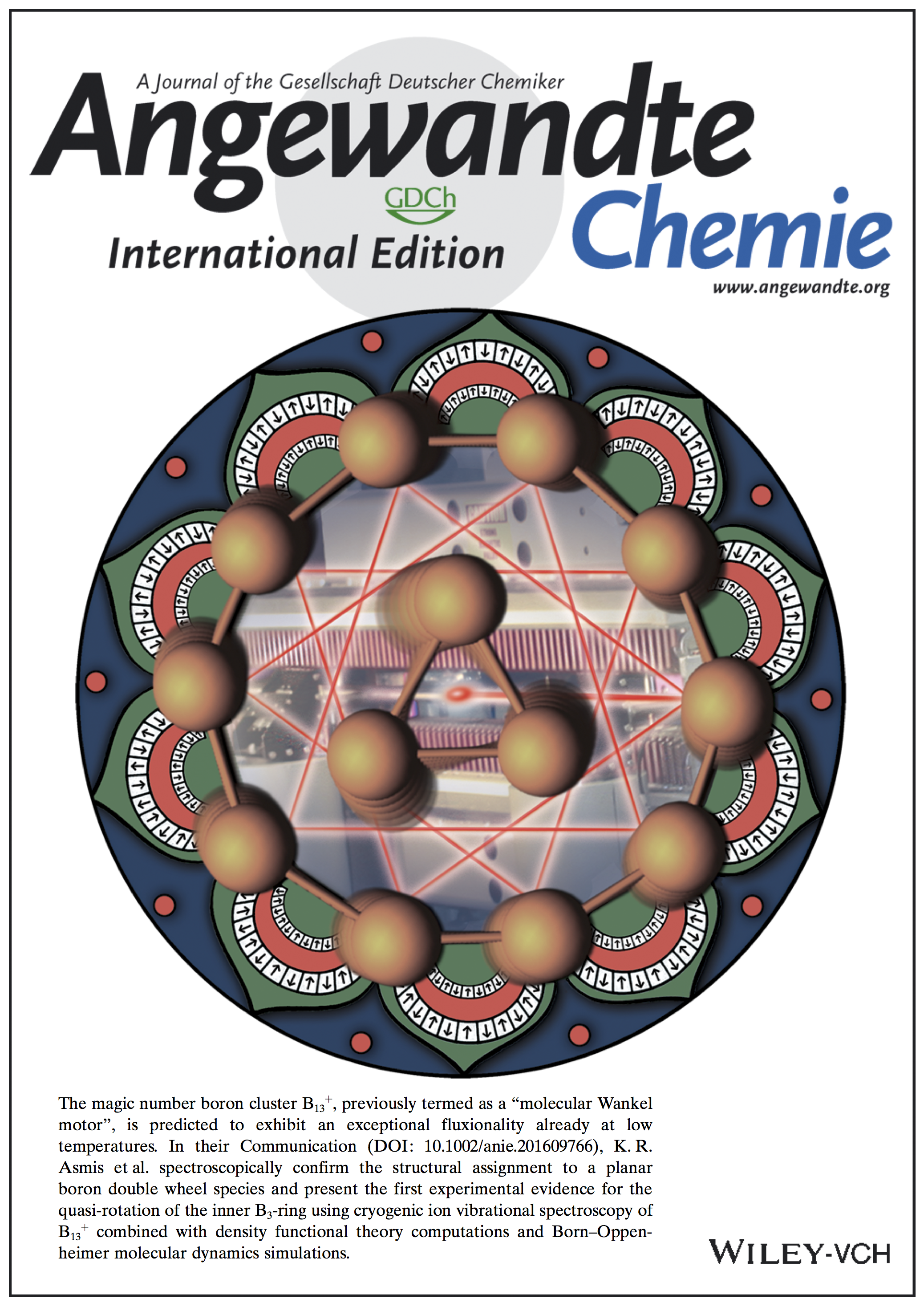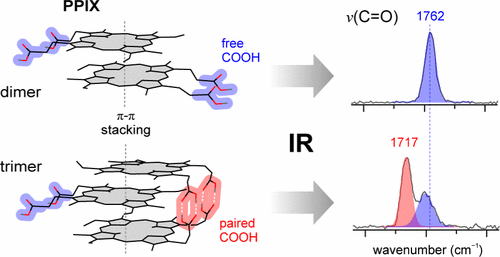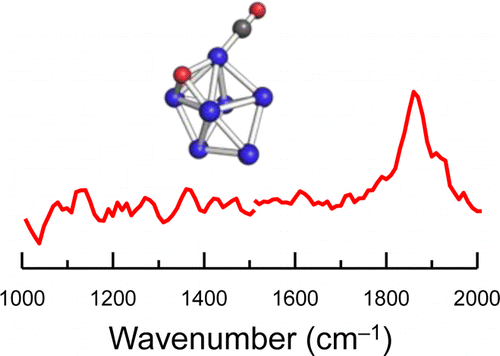
FEL
 AC
CP
MP
PC
TH
MPG
AC
CP
MP
PC
TH
MPG
The FHI FEL
- FEL home
- News
- Publications
- Specifications
- Live Monitor
- Pictures
- The people involved
- The FEL building
User experiments
- Gas phase ions
- Metal clusters
- Gas phase biomolecules
- Solid state lattice dynamics
- Surface spectroscopy
Links
Latest News

June 5, 2018:
The research group of Knut Asmis in collaboration with Shaodong Zhou and Helmut Schwarz (TU Berlin) investigated the [AlVOx]+./CO/N2O (x=3, 4) redox system by cryogenic ion vibrational spectroscopy using the FHI FEL radiation. In a publication that just appeared in Angewandte Chemie International Edition as a "Very Important Paper" Sreekanta Debnath et al. present how the intense IR radiation of the FHI FEL has been used in combination with electronic structure calculations to identify the active site in the oxygen-atom transfer reaction [AlVO4]+. + CO → [AlVO3]+. + CO2. Infrared photodissociation spectra of messenger‐tagged heteronuclear clusters demonstrate that in contrast to [AlVO4]+., [AlVO3]+. is devoid of a terminal Al−Ot unit while the terminal V=Ot group remains intact. Thus, it is the Al−Ot moiety that forms the active site in redox couple, which is in line with theoretical predictions.
Latest News
March 7, 2017: New publication
A new publication entitled Dissociative Water Adsorption by Al3O4+ in the Gas Phase by Matias R. Fagiani, Xiaowei Song, Sreekanta Debnath, Sandy Gewinner, Wieland Schöllkopf, Knut R. Asmis, Florian A. Bischoff, Fabian Müller, and Joachim Sauer just appeared in the Journal of Physical Chemistry Letters; J. Phys. Chem. Lett. 8, 1272 (2017). The publication presents a combined experimental and theoretical study of gas-phase clusters formed by 1 to 4 water molecules and a single Al3O4+ cluster. The results clearly indicate that the water molecules dissociate. Comparison of the observed vibrational spectra with the calculated ones allows to assign a structure to each of the four cationic aggregates.
Latest News
January 10, 2017:
The observation of a "molecular ball bearing" formed by 13 boron atoms (B13+) was presented in the Radio. Listen here to Knut Asmis being interviewed on Radio Mephisto.
The B13+ results have also been presented by a
press release of the Fritz Haber Institute, also in German;
Pressemitteilung.
Latest News
. 
Inside Cover of Angewandte Chemie Int. Ed. Vol. 56
December 21, 2016:
Due to their unusual electronic and structural properties boron clusters have recently attracted interest by experiment and theory alike. Especially the "magic" B13+ cluster has been known to be particularly stable. Theory predicted this cluster to exhibit a planar structure formed by two concentric rings, an outer ring of 10 and an inner ring of 3 boron atoms. In a publication that now appears in Angewandte Chemie International Edition Matias Fagiani et al. present how the intense infrared radiation of the FHI FEL has been used to measure the vibrational spectrum of B13+. The observed spectrum, in combination with density-functional theory, gives evidence for this double ring structure. Even better, the spectrum also reveals clear indication for a quasi-rotation of the inner ring within the outer ring. As this kind of rotational motion is reminiscent to a ball bearing, the B13+ cluster is referred to as a "molecular ball bearing".
 Matias Fagiani and Sreekanta Debnath, who observed the B13+ cluster, in front of the FEL undulator.
Matias Fagiani and Sreekanta Debnath, who observed the B13+ cluster, in front of the FEL undulator.
Latest News

December 13, 2016:
A new publication by Jongcheol Seo et al. entitled Stacking Geometries of Early Protoporphyrin IX Aggregates Revealed by Gas-Phase Infrared Spectroscopy just appeared in J. Am. Chem. Soc. In this work by the Group of Gert von Helden the IR radiation of the FEL was used to unravel the geometry of Protoporphyrin IX (PPIX) aggregates containing up to 8 monomers. The experiments reveal the linear stacking and the preferably alternating arrangement of the propionic side chains. Due to geometric constraints the side chains of the n-th and (n+2)-th monomer can form stabilizing hydrogen bonds. As a result the tetramer forms a relatively strongly bound aggregate with all side chains engaged in bonds. This makes further stacking to larger aggregates less likely, thereby explaining why previous attempts of forming PPIX nanostructures did not succeed.
Latest News
September 29, 2016: New publication
A new publication by Jongcheol Seo et al. entitled An infrared spectroscopy approach to follow β-sheet formation in peptide amyloid assemblies just appeared in Nature Chemistry, DOI:10.1038/NCHEM.2615. In this work a combination of gas-phase infrared spectroscopy and ion mobility-mass spectrometry was used to investigate the secondary structure of oligomers of the peptide segments VEALYL and YVEALL, consisting of 4–9 peptide strands. Peptide and protein oligomers of this kind play a crucial role as intermediates in fibril formation which is characteristic for neurodegenerative disorders such as Alzheimer’s and Parkinson’s disease. There has been increasing evidence that folding intermediates are the toxic species in these diseases. This motivates the establishment of methods allowing for structural analysis of such oligomers. The results presented in this work reveal oligomer structures with significant amounts of β-sheet structure.
Latest News
August 24, 2016: New publication
Aminobenzoic acids (ABA) and their corresponding ethyl esters (ABE) are biologically relevant molecules which are often used as building blocks for drugs or other biologically active molecules. ABA and ABE are also prototypical examples of molecules that offer two possible protonation sites: Their amine and carbonyl groups. In a new publication by Jongcheol Seo et al., Phys. Chem. Chem. Phys. 2016, DOI:10.1039/C6CP04941A, gas-phase infrared spectroscopy in combination with ion mobility-mass spectrometry and density functional theory calculations was used to determine the preferred protonation sites of para, metha, and ortho isomers of ABA and ABE. The results indicate that the site of protonation does not only depend on the intrinsic molecular properties such as resonance effects, but also critically on the environment of the molecules. In an aqueous environment, N-protonation is expected to be lowest in energy for all species that were investigated. In the gas phase, O-protonation can be preferable, and in those cases, both N- and O-protonated
species are observed.
Latest News

June 13, 2016:
A new publication entitled Size-Specific, Dissociative Activation of Carbon Dioxide by Cobalt Cluster Anions by Akimaro Yanagimachi, Kiichirou Koyasu, David Yubero Valdivielso, Sandy Gewinner, Wieland Schöllkopf, André Fielicke, and Tatsuya Tsukuda appeared on June 13, 2016 in the Journal of Physical Chemistry C 120, 14209–14215 (2016).
The publication presents experimental results from a collaboration of the groups of André Fielicke (TU Berlin & FHI) and Tatsuya Tsukuba (University of Tokyo, Japan). The IR radiation from the FHI FEL allowed for an observation of carbon dioxide dissociation on mass-selected cobalt cluster anions.
Latest News
April 8, 2016: New publication
A new publication entitled Gas phase vibrational spectroscopy of cold (TiO2)n- (n = 3–8) clusters by Marissa L. Weichman, Xiaowei Song, Matias R. Fagiani, Sreekanta Debnath, Sandy Gewinner, Wieland Schöllkopf, Daniel M. Neumark, and Knut R. Asmis just appeared in the Journal of Chemical Physics; J. Chem. Phys. 144, 124308 (2016). The publication presents experimental results from a collaboration of the groups of Knut Asmis (FHI & Leipzig University) and Dan Neumark (UC Berkeley, USA). The IR radiation from the FHI FEL has been applied to observe vibrational spectra of small mass-selected titanium oxide clusters.
Latest News

February 5, 2016:
The group of Gert von Helden (FHI), in collaboration with Kevin Pagel (FU Berlin & FHI), used the intense IR radiation from the FHI FEL to observe Coulomb driven unzipping of proteins. In this experiment ions of the proteins ubiquitin and cytochrome C, brought into the gas phase by electrospray ionization, were mass-to-charge selected and subsequently embedded in superfluid helium nano-droplets. In infrared spectra of the proteins, amide I (C=O stretch) and amide II (N–H bend) bands can be found at positions that are typical for condensed-phase proteins. For high charge states, however, a new band appears, substantially red-shifted from the amide II band observed at lower charge states. The observations are interpreted in terms of Coulomb-driven transitions in secondary structures from mostly helical to extended C5-type hydrogen-bonded structures. Support for this interpretation comes from simple energy considerations as well as from quantum chemical calculations on model peptides. This transition in secondary structure is most likely universal for isolated proteins that occur in mass spectrometric experiments.
A. I. González Flórez, E. Mucha, D.-S. Ahn, S. Gewinner, W. Schöllkopf, K. Pagel, and G. von Helden, Charge-Induced Unzipping of Isolated Proteins to a Defined Secondary Structure, Angewandte Chemie Int. Ed. (doi:10.1002/anie.201510983).
Latest News
January 12, 2016: New publication
The group of André Fielicke (TU Berlin & FHI), in collaboration with the group of Otto Dopfer (TU Berlin), used the IR radiation from the FHI FEL to unravel the structure of neutral boron-silicon clusters. The publication Characterization of neutral boron-silicon clusters using infrared spectroscopy: The case of Si6B by Nguyen Xuan Truong, Marko Haertelt, Bertram K.A. Jaeger, Sandy Gewinner, Wieland Schöllkopf, André Fielicke, and Otto Dopfer just appeared in the International Journal of Mass Spectrometry; Int. J. Mass Spectrom. 395, 1–6 (2016).